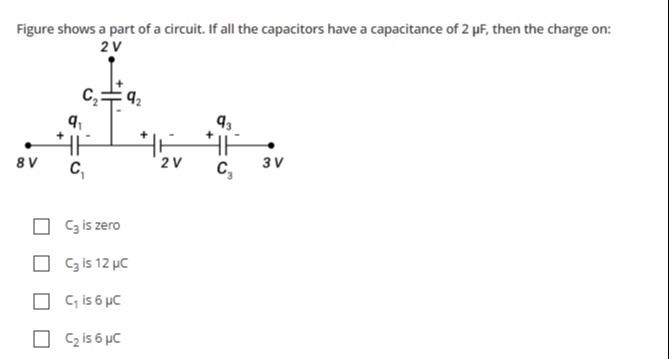Question
Question: Figure shows a part of a circuit. If all the capacitors have a capacitance of 2 µF, then the charge ...
Figure shows a part of a circuit. If all the capacitors have a capacitance of 2 µF, then the charge on:

A
C3 is zero
B
C3 is 12 µC
C
C₁ is 6 µC
D
C₂ is 6 µC
Answer
C₁ is 6 µC, C₂ is 6 µC
Explanation
Solution
Here's how to solve this problem, considering a common interpretation in circuit analysis:
- Identify the Potentials:
- Leftmost node: 8 V
- Top node: 2 V
- Middle node (connected to C3): 2 V
- Rightmost node: 3 V
- Initial Assumption and Issue:
- If we assume the junction of C1 and C2 is directly connected to the middle 2V node, then its potential (V_J) is 2V.
- Calculate charges:
- Q1 = C * (8 - 2) = 2 µF * 6 V = 12 µC
- Q2 = C * (2 - 2) = 2 µF * 0 V = 0 µC
- Q3 = C * (2 - 3) = 2 µF * (-1 V) = -2 µC
- None of the options match these values.
- Alternative Interpretation (Isolated Junction):
- Assume the "2V" label in the middle is only for C3, and the junction (V_J) is an isolated node.
- In this case, the net charge on the isolated plates connected to V_J must be zero.
- Charge Conservation:
- Charge on the right plate of C1: -Q1 = -C(8 - V_J)
- Charge on the bottom plate of C2: +Q2 = +C(V_J - 2)
- Sum of charges = 0: -C(8 - V_J) + C(V_J - 2) = 0
- Solve for V_J:
- -(8 - V_J) + (V_J - 2) = 0
- -8 + V_J + V_J - 2 = 0
- 2V_J = 10 => V_J = 5 V
- Recalculate Charges with V_J = 5 V:
- Charge on C1 (Q1): Q1 = C * (8 V - V_J) = 2 µF * (8 V - 5 V) = 2 µF * 3 V = 6 µC
- Charge on C2 (Q2): Q2 = C * (V_J - 2 V) = 2 µF * (5 V - 2 V) = 2 µF * 3 V = 6 µC
- Charge on C3 (Q3): Q3 = C * (2 V - 3 V) = 2 µF * (-1 V) = -2 µC
- Match with Options:
- With V_J = 5 V:
- C1 is 6 µC: True
- C2 is 6 µC: True
Therefore, the intended solution likely assumes the junction is isolated, leading to multiple correct options.
